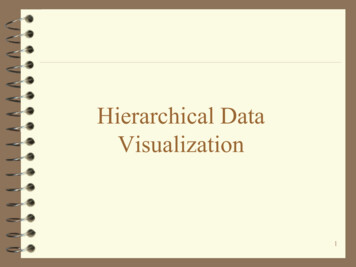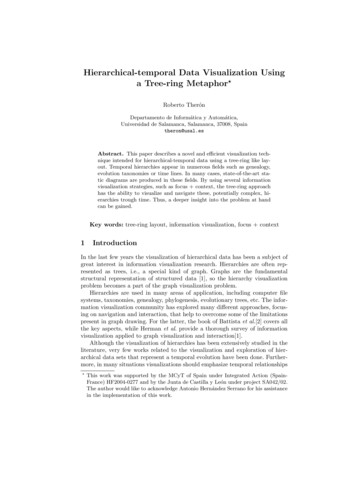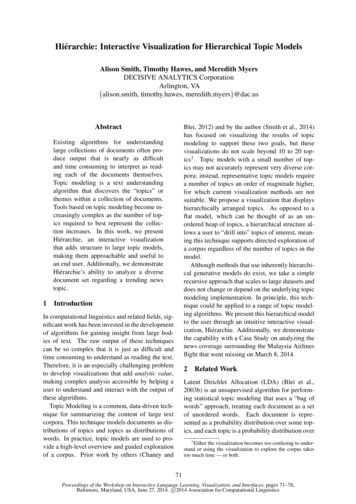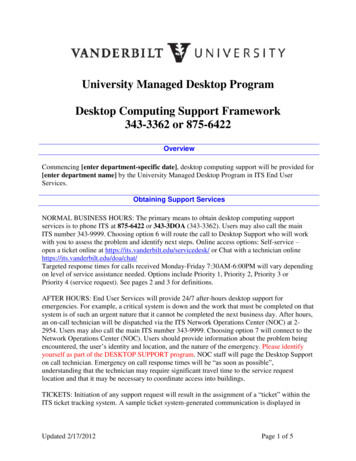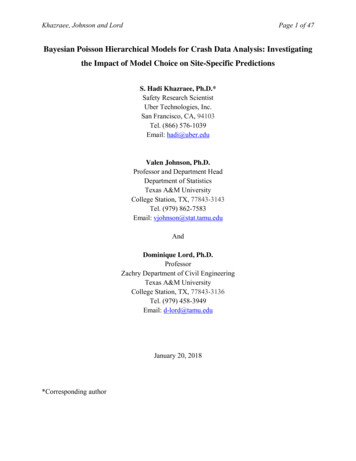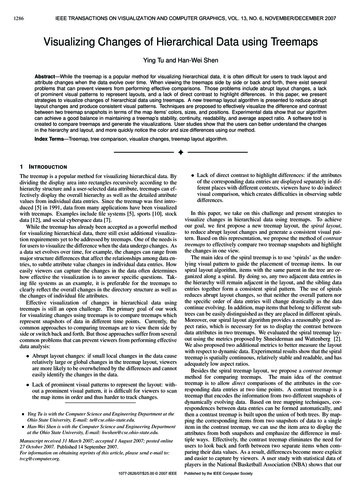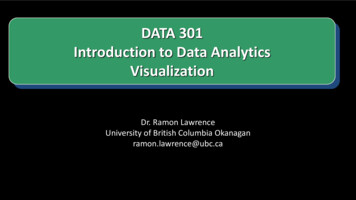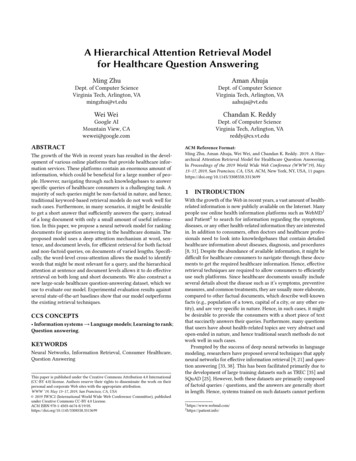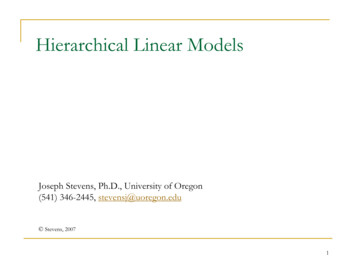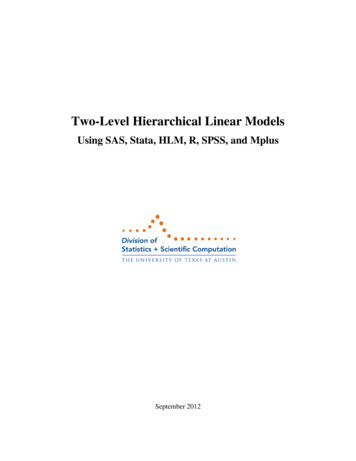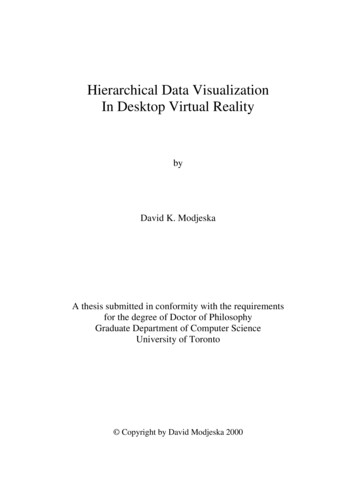
Transcription
Hierarchical Data VisualizationIn Desktop Virtual RealitybyDavid K. ModjeskaA thesis submitted in conformity with the requirementsfor the degree of Doctor of PhilosophyGraduate Department of Computer ScienceUniversity of Toronto Copyright by David Modjeska 2000
Hierarchical Data Visualization in Desktop Virtual Realityby David K. ModjeskaPh.D. ThesisDepartment of Computer ScienceUniversity of Toronto2000AbstractWhile desktop virtual reality (VR) offers a way to visualize structure in large information sets, therehave been relatively few empirical investigations of visualization designs in this domain. This thesisreports the development and testing of a series of prototype desktop VR worlds, which were designedto support navigation during information visualization and retrieval. Four methods were used for datacollection: search task scoring, subjective questionnaires, navigational activity logging and analysis,and administration of tests for spatial and structure-learning ability. The combination of these researchmethods revealed significant effects of user abilities, information environment designs, and tasklearning.The first of four studies compared three versions of a structured virtual landscape, finding significantdifferences in sense of presence, ease of use, and overall enjoyment; there was, however, no significant difference in performance among the three landscape versions. The second study found ahypertext interface to be superior to a VR interface for task performance, ease of use, and rated efficiency; nevertheless, the VR interface was rated as more enjoyable. The third study used a new layoutalgorithm; the resulting prototype was rated as easier to use and more efficient than the previous VRversion. In the fourth study, a zoomable, map-like view of the newest VR prototype was developed.Experimental participants found the map-view superior to the 3D-view for task performance and ratedefficiency.Overall, this research did not find a performance advantage for using 3D versions of VR. In addition,the results of the fourth study found that people in the lowest quartile of spatial ability had significantly lower search performance (relative to the highest three quartiles) in a VR world. This findingsuggests that individual differences for traits such as spatial ability may be important in determiningthe usability and acceptability of VR environments.In addition to the experimental results summarized above, this thesis also developed and refined amethodology for investigating tasks, users, and software in 3D environments. This methodology included tests for spatial and structure-learning abilities, as well as logging and analysis of a user’snavigational activities.ii
Table of ContentsAbstract . . . . . . . . . . . . . . . . . . . . . . . . . . . . . . . . . . . . . . . . . . . . . . . . . . . . . . . . . . . . . . . . iiAcknowledgements . . . . . . . . . . . . . . . . . . . . . . . . . . . . . . . . . . . . . . . . . . . . . . . . . . . . . . . Error!Bookmark not defined.Table of Contents . . . . . . . . . . . . . . . . . . . . . . . . . . . . . . . . . . . . . . . . . . . . . . . . . . . . . . . . iiiList of Tables . . . . . . . . . . . . . . . . . . . . . . . . . . . . . . . . . . . . . . . . . . . . . . . . . . . . . . . . . . . . Error!Bookmark not defined.List of Figures . . . . . . . . . . . . . . . . . . . . . . . . . . . . . . . . . . . . . . . . . . . . . . . . . . . . . . . . . . . Error!Bookmark not defined.List of Appendices . . . . . . . . . . . . . . . . . . . . . . . . . . . . . . . . . . . . . . . . . . . . . . . . . . . . . . . .Error!Bookmark not defined.1. Introduction . . . . . . . . . . . . . . . . . . . . . . . . . . . . . . . . . . . . . . . . . . . . . . . . . . . . . . . . . 11.1.Research Context . . . . . . . . . . . . . . . . . . . . . . . . . . . . . . . . . . . . . . . . . . . . . . . .11.2.Research Questions . . . . . . . . . . . . . . . . . . . . . . . . . . . . . . . . . . . . . . . . . . . . . . 21.3.Thesis Perspective and Organization . . . . . . . . . . . . . . . . . . . . . . . . . . . . . . . . 72. Related Research . . . . . . . . . . . . . . . . . . . . . . . . . . . . . . . . . . . . . . . . . . . . . . . . . . . . . Error!Bookmark not defined.2.1.Introduction . . . . . . . . . . . . . . . . . . . . . . . . . . . . . . . . . . . . . . . . . . . . . . . . . . . . Error!Bookmark not defined.2.2.Cognitive Engineering and UI Metaphors . . . . . . . . . . . . . . . . . . . . . . . . . . . . Error!Bookmark not defined.2.3.Information Structuring . . . . . . . . . . . . . . . . . . . . . . . . . . . . . . . . . . . . . . . . . . .Error!Bookmark not defined.2.3.1.Semantic vs. Physical Models . . . . . . . . . . . . . . . . . . . . . . . . . . . . . . . . . . Error!Bookmark not defined.2.3.2.Structure Types . . . . . . . . . . . . . . . . . . . . . . . . . . . . . . . . . . . . . . . . . . . . . Error!Bookmark not defined.2.3.3.Hierarchical Structures . . . . . . . . . . . . . . . . . . . . . . . . . . . . . . . . . . . . . . . Error!Bookmark not defined.2.3.4.Experimental Results . . . . . . . . . . . . . . . . . . . . . . . . . . . . . . . . . . . . . . . . . Error!Bookmark not defined.2.3.5.Designs for Hypermedia and Spatial Worlds . . . . . . . . . . . . . . . . . . . . . . Error!Bookmark not defined.2.3.6.Discussion . . . . . . . . . . . . . . . . . . . . . . . . . . . . . . . . . . . . . . . . . . . . . . . . . Error!Bookmark not defined.iii
2.4.Physical and Information Exploration . . . . . . . . . . . . . . . . . . . . . . . . . . . . . . . Error!Bookmark not defined.2.4.1.General Models . . . . . . . . . . . . . . . . . . . . . . . . . . . . . . . . . . . . . . . . . . . . . .Error!Bookmark not defined.2.4.2.Mental Maps . . . . . . . . . . . . . . . . . . . . . . . . . . . . . . . . . . . . . . . . . . . . . . . . Error!Bookmark not defined.2.4.3.Wayfinding . . . . . . . . . . . . . . . . . . . . . . . . . . . . . . . . . . . . . . . . . . . . . . . . . Error!Bookmark not defined.2.4.4.Hypermedia Environments . . . . . . . . . . . . . . . . . . . . . . . . . . . . . . . . . . . . . Error!Bookmark not defined.2.4.5.Spatial Ability in Electronic Environments . . . . . . . . . . . . . . . . . . . . . . . . Error!Bookmark not defined.2.4.6.Discussion . . . . . . . . . . . . . . . . . . . . . . . . . . . . . . . . . . . . . . . . . . . . . . . . . .Error!Bookmark not defined.2.5.Information Visualization . . . . . . . . . . . . . . . . . . . . . . . . . . . . . . . . . . . . . . . . . Error!Bookmark not defined.2.5.1.Fisheye Views . . . . . . . . . . . . . . . . . . . . . . . . . . . . . . . . . . . . . . . . . . . . . . .Error!Bookmark not defined.2.5.2.Semantic Zooming . . . . . . . . . . . . . . . . . . . . . . . . . . . . . . . . . . . . . . . . . . . Error!Bookmark not defined.2.5.3.Cone Tree, Hyperbolic Browser, and Butterfly . . . . . . . . . . . . . . . . . . . . . Error!Bookmark not defined.2.5.4.Visualization for Information Retrieval . . . . . . . . . . . . . . . . . . . . . . . . . . . Error!Bookmark not defined.2.5.5.Spaces for Public Information . . . . . . . . . . . . . . . . . . . . . . . . . . . . . . . . . . Error!Bookmark not defined.2.5.6.Visualizing Hypermedia Structure . . . . . . . . . . . . . . . . . . . . . . . . . . . . . . . Error!Bookmark not defined.2.5.7.Discussion . . . . . . . . . . . . . . . . . . . . . . . . . . . . . . . . . . . . . . . . . . . . . . . . . .Error!Bookmark not defined.2.6.Summary . . . . . . . . . . . . . . . . . . . . . . . . . . . . . . . . . . . . . . . . . . . . . . . . . . . . . . Error!Bookmark not defined.2.7.Conclusions . . . . . . . . . . . . . . . . . . . . . . . . . . . . . . . . . . . . . . . . . . . . . . . . . . . . Error!Bookmark not defined.3. Study 1 – Day, Dusk, and Night Worlds . . . . . . . . . . . . . . . . . . . . . . . . . . . . . . . . . . Error!Bookmark not defined.iv
3.1.Introduction . . . . . . . . . . . . . . . . . . . . . . . . . . . . . . . . . . . . . . . . . . . . . . . . . . . . Error!Bookmark not defined.3.2.Methodology . . . . . . . . . . . . . . . . . . . . . . . . . . . . . . . . . . . . . . . . . . . . . . . . . . . Error!Bookmark not defined.3.2.1.Apparatus . . . . . . . . . . . . . . . . . . . . . . . . . . . . . . . . . . . . . . . . . . . . . . . . . . Error!Bookmark not defined.3.2.1.1.Description . . . . . . . . . . . . . . . . . . . . . . . . . . . . . . . . . . . . . . . . . . Error!Bookmark not defined.3.2.1.2.Development . . . . . . . . . . . . . . . . . . . . . . . . . . . . . . . . . . . . . . . . . Error!Bookmark not defined.3.2.2.Procedure . . . . . . . . . . . . . . . . . . . . . . . . . . . . . . . . . . . . . . . . . . . . . . . . . . Error!Bookmark not defined.3.2.3.Measures . . . . . . . . . . . . . . . . . . . . . . . . . . . . . . . . . . . . . . . . . . . . . . . . . . . Error!Bookmark not defined.3.3.Results . . . . . . . . . . . . . . . . . . . . . . . . . . . . . . . . . . . . . . . . . . . . . . . . . . . . . . . . Error!Bookmark not defined.3.3.1.Description . . . . . . . . . . . . . . . . . . . . . . . . . . . . . . . . . . . . . . . . . . . . . . . . . Error!Bookmark not defined.3.3.2.Underlying Factors of Performance . . . . . . . . . . . . . . . . . . . . . . . . . . . . . . Error!Bookmark not defined.3.3.3.Effects on User Strategy . . . . . . . . . . . . . . . . . . . . . . . . . . . . . . . . . . . . . . . Error!Bookmark not defined.3.3.4.Learning Effects within Blocks . . . . . . . . . . . . . . . . . . . . . . . . . . . . . . . . . Error!Bookmark not defined.3.3.5.Experimental Control . . . . . . . . . . . . . . . . . . . . . . . . . . . . . . . . . . . . . . . . . Error!Bookmark not defined.3.4.Conclusions . . . . . . . . . . . . . . . . . . . . . . . . . . . . . . . . . . . . . . . . . . . . . . . . . . . . Error!Bookmark not defined.4. Study 2 – VR vs. Hypertext . . . . . . . . . . . . . . . . . . . . . . . . . . . . . . . . . . . . . . . . . . . . . Error!Bookmark not defined.4.1.Introduction . . . . . . . . . . . . . . . . . . . . . . . . . . . . . . . . . . . . . . . . . . . . . . . . . . . . Error!Bookmark not defined.4.2.Methodology . . . . . . . . . . . . . . . . . . . . . . . . . . . . . . . . . . . . . . . . . . . . . . . . . . . Error!Bookmark not defined.4.2.1.Apparatus . . . . . . . . . . . . . . . . . . . . . . . . . . . . . . . . . . . . . . . . . . . . . . . . . . Error!Bookmark not defined.v
4.2.2.Procedure . . . . . . . . . . . . . . . . . . . . . . . . . . . . . . . . . . . . . . . . . . . . . . . . . . Error!Bookmark not defined.4.2.3.Measures . . . . . . . . . . . . . . . . . . . . . . . . . . . . . . . . . . . . . . . . . . . . . . . . . . . Error!Bookmark not defined.4.3.Results . . . . . . . . . . . . . . . . . . . . . . . . . . . . . . . . . . . . . . . . . . . . . . . . . . . . . . . . Error!Bookmark not defined.4.3.1.Description . . . . . . . . . . . . . . . . . . . . . . . . . . . . . . . . . . . . . . . . . . . . . . . . . Error!Bookmark not defined.4.3.2.Underlying Factors of Performance . . . . . . . . . . . . . . . . . . . . . . . . . . . . . . Error!Bookmark not defined.4.3.3.Effects on User Strategy . . . . . . . . . . . . . . . . . . . . . . . . . . . . . . . . . . . . . . . Error!Bookmark not defined.4.3.4.Experimental Control . . . . . . . . . . . . . . . . . . . . . . . . . . . . . . . . . . . . . . . . . Error!Bookmark not defined.4.4.Conclusions . . . . . . . . . . . . . . . . . . . . . . . . . . . . . . . . . . . . . . . . . . . . . . . . . . . . Error!Bookmark not defined.5. Study 3 – Naturalistic vs. Efficient Worlds . . . . . . . . . . . . . . . . . . . . . . . . . . . . . . . . Error!Bookmark not defined.5.1.Introduction . . . . . . . . . . . . . . . . . . . . . . . . . . . . . . . . . . . . . . . . . . . . . . . . . . . . Error!Bookmark not defined.5.2.Methodology . . . . . . . . . . . . . . . . . . . . . . . . . . . . . . . . . . . . . . . . . . . . . . . . . . . Error!Bookmark not defined.5.2.1.Apparatus . . . . . . . . . . . . . . . . . . . . . . . . . . . . . . . . . . . . . . . . . . . . . . . . . . Error!Bookmark not defined.5.2.2.Procedure . . . . . . . . . . . . . . . . . . . . . . . . . . . . . . . . . . . . . . . . . . . . . . . . . . Error!Bookmark not defined.5.2.3.Measures . . . . . . . . . . . . . . . . . . . . . . . . . . . . . . . . . . . . . . . . . . . . . . . . . . . Error!Bookmark not defined.5.3.Results . . . . . . . . . . . . . . . . . . . . . . . . . . . . . . . . . . . . . . . . . . . . . . . . . . . . . . . . Error!Bookmark not defined.5.3.1.Description . . . . . . . . . . . . . . . . . . . . . . . . . . . . . . . . . . . . . . . . . . . . . . . . . Error!Bookmark not defined.5.3.2.Underlying Factors of Performance . . . . . . . . . . . . . . . . . . . . . . . . . . . . . . Error!Bookmark not defined.5.3.3.Effects on User Strategy . . . . . . . . . . . . . . . . . . . . . . . . . . . . . . . . . . . . . . . Error!Bookmark not defined.vi
5.3.4.Experimental Control . . . . . . . . . . . . . . . . . . . . . . . . . . . . . . . . . . . . . . . . . Error!Bookmark not defined.5.3.5.Discussion . . . . . . . . . . . . . . . . . . . . . . . . . . . . . . . . . . . . . . . . . . . . . . . . . .Error!Bookmark not defined.5.4.Conclusions . . . . . . . . . . . . . . . . . . . . . . . . . . . . . . . . . . . . . . . . . . . . . . . . . . . . Error!Bookmark not defined.6. Study 4 – Map-view vs. Fly-through . . . . . . . . . . . . . . . . . . . . . . . . . . . . . . . . . . . . . .86.1.Introduction . . . . . . . . . . . . . . . . . . . . . . . . . . . . . . . . . . . . . . . . . . . . . . . . . . . . 86.2.Methodology . . . . . . . . . . . . . . . . . . . . . . . . . . . . . . . . . . . . . . . . . . . . . . . . . . . 96.3.6.4.6.2.1.Apparatus . . . . . . . . . . . . . . . . . . . . . . . . . . . . . . . . . . . . . . . . . . . . . . . . . . 96.2.2.Procedure . . . . . . . . . . . . . . . . . . . . . . . . . . . . . . . . . . . . . . . . . . . . . . . . . . 106.2.3.Measures . . . . . . . . . . . . . . . . . . . . . . . . . . . . . . . . . . . . . . . . . . . . . . . . . . . 11Results . . . . . . . . . . . . . . . . . . . . . . . . . . . . . . . . . . . . . . . . . . . . . . . . . . . . . . . . 136.3.1.Description . . . . . . . . . . . . . . . . . . . . . . . . . . . . . . . . . . . . . . . . . . . . . . . . . 136.3.2.Underlying Factors of Performance . . . . . . . . . . . . . . . . . . . . . . . . . . . . . . 146.3.3.Effects on User Strategy . . . . . . . . . . . . . . . . . . . . . . . . . . . . . . . . . . . . . . . 186.3.4.Learning Effects within Blocks . . . . . . . . . . . . . . . . . . . . . . . . . . . . . . . . . 226.3.5.Data Classification . . . . . . . . . . . . . . . . . . . . . . . . . . . . . . . . . . . . . . . . . . . 246.3.6.Linear Regression . . . . . . . . . . . . . . . . . . . . . . . . . . . . . . . . . . . . . . . . . . . . 256.3.7.Experimental Control . . . . . . . . . . . . . . . . . . . . . . . . . . . . . . . . . . . . . . . . . 266.3.8.Summary of Results . . . . . . . . . . . . . . . . . . . . . . . . . . . . . . . . . . . . . . . . . . 30Conclusions . . . . . . . . . . . . . . . . . . . . . . . . . . . . . . . . . . . . . . . . . . . . . . . . . . . . 317. Conclusions . . . . . . . . . . . . . . . . . . . . . . . . . . . . . . . . . . . . . . . . . . . . . . . . . . . . . . . . . . 337.1.Summary . . . . . . . . . . . . . . . . . . . . . . . . . . . . . . . . . . . . . . . . . . . . . . . . . . . . . . .337.2.Methodology and Spatial/Semantic Issues . . . . . . . . . . . . . . . . . . . . . . . . . . . . . 347.3.Performance, Ease of Use and Efficiency . . . . . . . . . . . . . . . . . . . . . . . . . . . . . .357.4.Sense of Presence, Enjoyment, and 3D . . . . . . . . . . . . . . . . . . . . . . . . . . . . . . . 367.5.Contributions . . . . . . . . . . . . . . . . . . . . . . . . . . . . . . . . . . . . . . . . . . . . . . . . . . . 367.6.Future Work . . . . . . . . . . . . . . . . . . . . . . . . . . . . . . . . . . . . . . . . . . . . . . . . . . . . 387.7.7.6.1.User Performance and Attitude . . . . . . . . . . . . . . . . . . . . . . . . . . . . . . . . . 387.6.2.Visualization Prototypes . . . . . . . . . . . . . . . . . . . . . . . . . . . . . . . . . . . . . . .387.6.3.Research Methodology . . . . . . . . . . . . . . . . . . . . . . . . . . . . . . . . . . . . . . . . 39Final Comments . . . . . . . . . . . . . . . . . . . . . . . . . . . . . . . . . . . . . . . . . . . . . . . . . 39Reference List . . . . . . . . . . . . . . . . . . . . . . . . . . . . . . . . . . . . . . . . . . . . . . . . . . . . . . . . . . . 41vii
“In cyberspace, information-intensive institutions and businesses have a form, identity, and workingreality--in a word and quite literally, an architecture--that is counterpart and different to the form,identity, and working reality they have in the physical world. The ordinary physical reality of theseinstitutions, businesses, etc., are seen as surface phenomena, as husks, their true energy coursing inarchitectures unseen except in cyberspace.”-- from “Cyberspace: Some Proposals” by Michael Benediktviii
Chapter 1Introduction1.1 Research ContextAs the volume and complexity of the information sphere grows, more advanced techniques are neededto visualize it. Such techniques, generally known as instances of information visualization, can beseen as moving information from abstractions to representations. Similarly, as the power and sophistication of computer technology increases, its ability to simulate the world also increases. Suchapproaches, generally known as virtual reality (VR), move information in the opposite direction, i.e.,from concrete representation to abstraction. These two trends are starting to meet in the domain ofinformation visualization using desktop VR. This meeting may eventually enable significant improvements in the everyday accessibility of large information sets.Information visualization addresses the problem of representing various data types for the end-user, sothat the data can more easily be understood, managed, and communicated. A variety of techniques hasbeen developed to handle both structured and unstructured data, especially for scientific and industrialtasks. The hallmark of such techniques is a mapping from a source data domain to a destination visualdomain, where task-dependent objects and relationships become apparent (visible) and available. Asecondary goal is to offload part of the burden of conscious information processing to the human perceptual system (Robertson, Mackinlay, & Card, 1991). While often powerful, existing techniquesgenerally place the user in a third-person perspective with regard to data, or perhaps in a first-personperspective in a limited visual space. Richer possibilities for exploiting human navigational knowledge are open for research and development. Moreover, it is unclear how some existing techniqueswould scale up for the size and complexity of very large data sets.VRuses the techniques of computer graphics to present a model environment to the senses through avariety of computer media, ranging from full-body immersion to traditional desktop display. An informal definition of VR is as follows (Neill, 1994):Virtual Reality is a combination of hardware and software that allows you to see, move around inand manipulate computer graphics. . . . there are two basic components that a true virtual realityprogram must contain: 1) A first-person viewpoint that has complete movement at will in realtime; 2) The ability to manipulate and/or change the virtual environment in real time (that is, thecomputer processes and displays the simulation as you experience it instead of playing prerecorded sequences . . .).1
2The applications of VR to date have primarily been in engineering and architectural design (CAD),communication (virtual communities), and entertain
The best opportunities to use VR for large-scale visualization currently lies with browsing hierarchical data, for two reasons. First, the world’s largest information structure is the Web. Individual Web sites often have a generally hierarchical structure (n.
